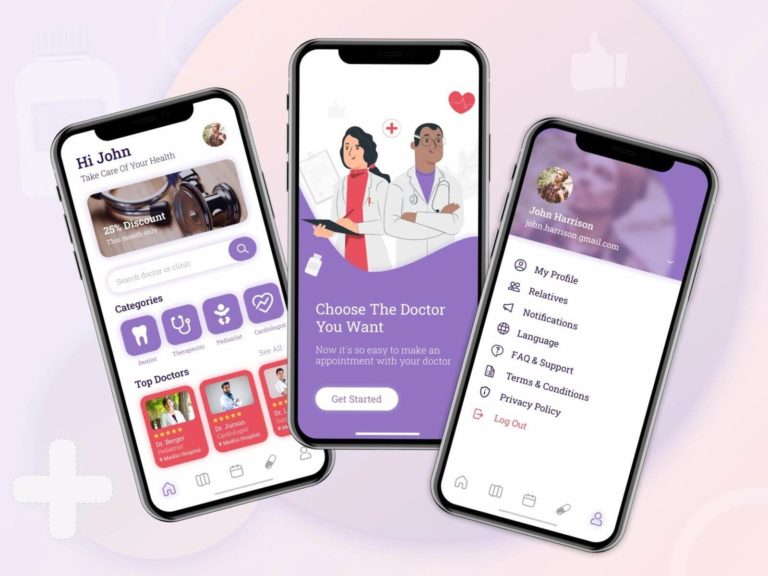How to Create a Telemedicine App and How Much It Costs
Half of US hospitals already have telemedicine programs, but telemedicine is also interesting for entrepreneurs, private practices, healthcare systems, medical organizations, and even insurance companies. So what is telemedicine and how can you make it work for your business? Find out in this article.
The telemedicine trend
The global telemedicine market was valued at $50 billion in 2019. By 2030 it’s predicted to reach $460 billion, according to Statista.

Why has telemedicine app development experienced such a big boom? There are several reasons:
Available at all times
People postpone doctor visits for many reasons: they’re too busy to bother going to a clinic with a minor issue, their doctor isn’t available, and so on. In some countries, particularly in Africa, there’s a shortage of doctors, and they have no possibility of satisfying everyone’s needs.
Telemedicine applications for healthcare are accessible because it requires less time: to visit a doctor, a patient only needs to launch an app and press a few buttons.
Cost-effective
Telemedicine is definitely profitable. It’s much easier and cheaper to create and maintain a single mobile app than to open your own clinic. This is why many entrepreneurs are currently starting this type of business.
For healthcare businesses that already have a physical location like a hospital, clinic, or medical center, telemedicine offers an additional source of revenue. With an mHealth app, doctors can help more patients each day, and medical facilities can provide better service.
Secure
If they comply with all laws and regulations, mobile healthcare apps can securely exchange data between doctors and patients.
Less red tape
Mobile apps send all data to servers that store it and connect it to a CRM. With the help of a mobile app, conversation recordings, and health record sharing, doctors and patients can access data at all times from a telemedicine software platform and make their work more effective. This means that when a patient goes to a different doctor, they can immediately see their health history and help the patient more effectively.
Further, we’ll discuss the features you need to make a solid telemedicine app, the details to consider, and the potential budget for a native app. Note that you can also create a cross-platform solution for around 30% to 40% less using technologies like Flutter.
The role of telemedicine applications in healthcare
The COVID-19 pandemic has changed the telemedicine market landscape drastically. Before the pandemic, only 11% of patients were interested in having online consultations with doctors. During the pandemic, this number spiked at 76%, and now, in the post-COVID era, it has stabilized at around 35%. By 2025, 45% of all patients are expected to be regular users of telemedicine services.
Now, patients express more interest in telemedicine as they’re more used to it after the pandemic. They also trust the technology more and have recognized its convenience.
So, now the role of telemedicine apps in healthcare has become more significant than it was before. It helps to optimize the work of healthcare providers by saving time for both doctors and patients and reducing the wait time for non-urgent matters.
Top 4 telemedicine technologies
- Machine learning
- Artificial intelligence
- Blockchain
- Big data
Telemedicine software is varied: you can make a relatively simple app that connects doctors and patients, or you can create an app that’s integrated with your whole business ecosystem and helps you automate your processes and optimize doctors’ work.
Most telemedicine startups with complex apps use these technologies:
Machine learning
It teaches software to derive insights from huge blocks of data and thus helps doctors make faster and more accurate decisions about their patients’ health.
Artificial intelligence
AI powers chatbots, voice recognition, and other features that can help patients before the doctor steps in. This helps to optimize doctors’ time and provide instant help at all times.
Blockchain
Blockchain technologies help to provide highly secure data transfers and data storage, which is paramount for healthcare apps that store sensitive patient data that hackers are hungry for.
Big data
Big data technologies gather every single detail about a patient’s health history, making it faster for a doctor to dive into the context and help each patient based on their individual needs, previous diseases, allergies, and so on.
All these technologies are rather costly to implement, but they make a big difference in the way your business functions, allowing you to save money in the long run and provide the best service possible.
3 best telemedicine apps 2023
These are some examples of the best telemedicine apps that set standards for the whole industry and can serve as an inspiration for your own telemedicine app development project.
Doxy.Me
Doxy.Me is a telemedicine app that’s available for Android, iOS, and desktop operating systems. It’s a cloud-based service, so you don’t need to download it: just register and use it for free. Doxy.Me allows calls, text, and audio chats with doctors, access to EHR, and more. There are also paid tiers:
The professional tier costs $35 per month and offers the ability to edit waiting rooms and schedule appointments.
The clinic tier costs $50 per month and allows group video calls, screen, and file sharing, as well as making payments right through the app.
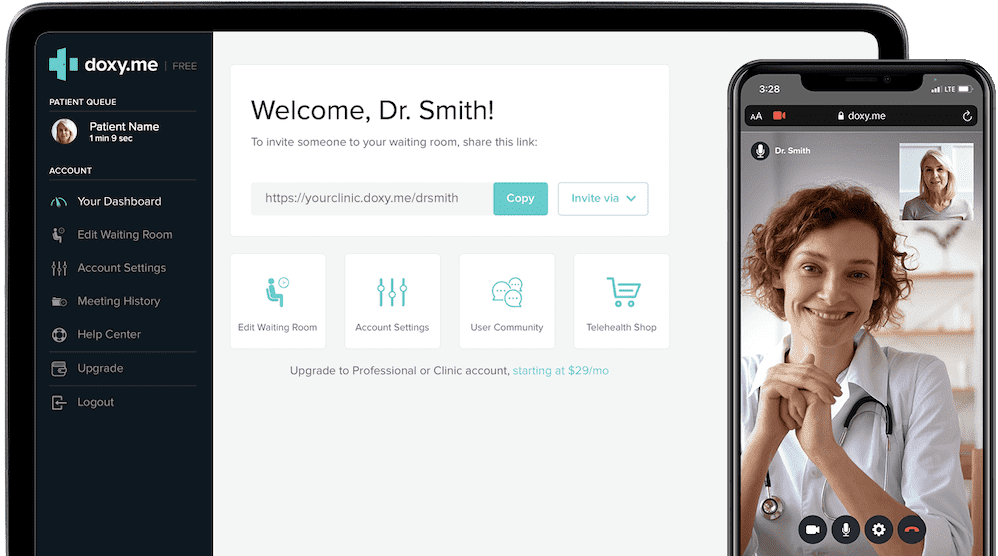
Spruce Health
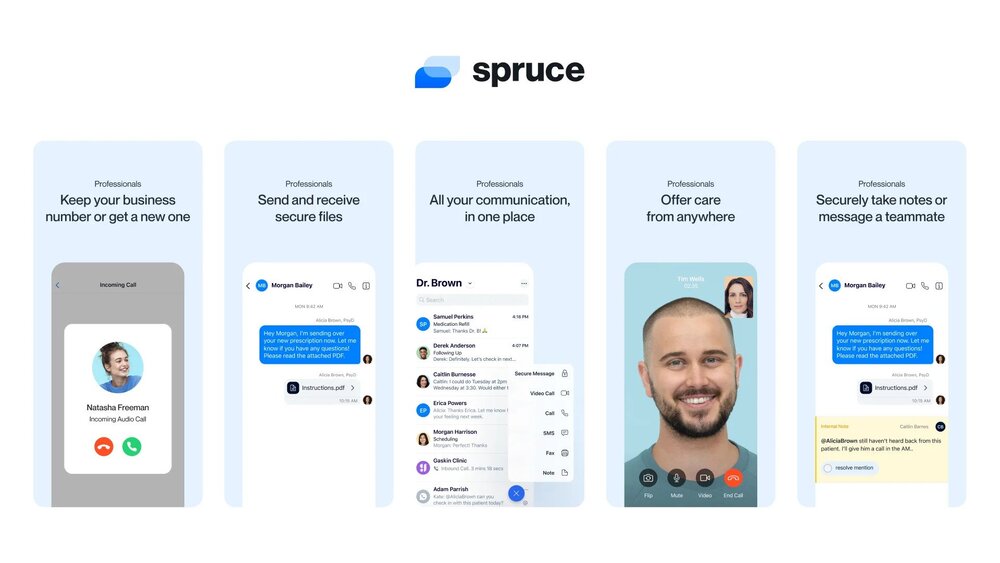
Spruce Health is an all-in-one platform that allows doctors to facilitate all the stages of their interactions with patients, including messaging, mail, voicemails, fax, video, and of course, telemedicine. This platform is compliant with HIPAA and provides healthcare practices with powerful tools that can help manage the whole system.
Spruce provides workflow automation, payment processing, bulk messaging, after-hours phone tools, EHR integrations, and more.
Mend
Scheduling a call doesn’t mean showing up to it, and many doctors who work remotely with their patients suffer from missed calls and video conferences. Mend uses SMS notifications and reminders to reduce the chance of a missed appointment to zero. In Mend, patients can schedule their appointments themselves.
Mend offers doctors easy-to-use drag-and-drop online forms and automated workflows to increase the effectiveness of every doctor. The price for Mend starts at $69 per provider.
As you can see, all three telemedicine examples have their own business models and key advantages. Let’s talk about what exactly makes them successful and what you should strive for.
How do telemedicine applications work?
The main service a telemedicine app provides is the ability to connect with a doctor remotely. This can be made either through a patient portal or via video conferencing.
After the patient authorization, a patient can enter the system, email their doctor, request prescription refills, and set up appointments.
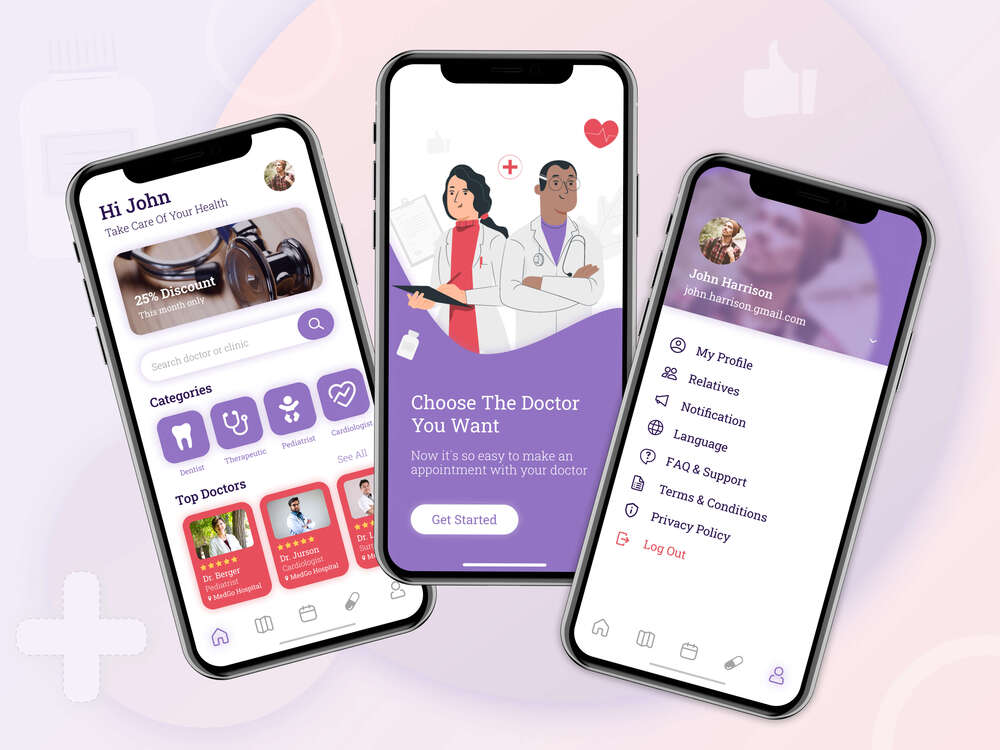
During an actual online appointment, telemedicine apps work like a two-way live-streaming video chat that allows doctors and patients to see and hear each other during their session as if they were talking in person.
Usually, when we think of telemedicine, we imagine those online sessions, but telemedicine apps help to facilitate all the stages of patient-doctor interaction.
What would make a successful telehealth app
1. Feature stack
According to the Healthcare Business & Technology report, only 11% of all mHealth apps offer at least one of three most requested features that patients want to see in their apps:
- access to EHR
- online appointment scheduling
- online prescription refill
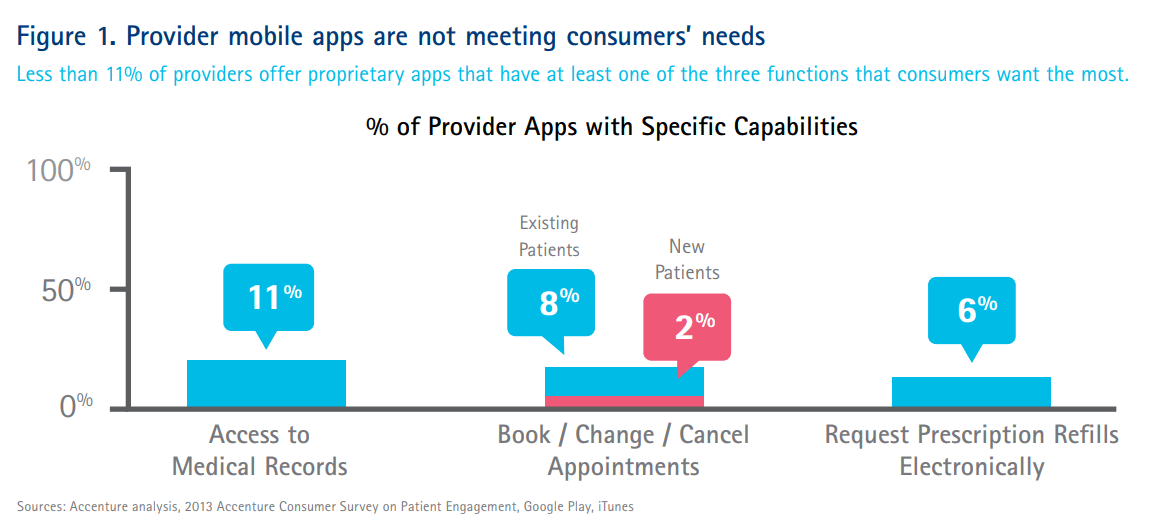
You can win over the majority of apps by just adding those features to your telemedicine app.
2. UI/UX
Often, user experience in telemedicine apps is far from intuitive, smooth, and user-friendly. You should work on making your app as simple and concise as possible to retain your users. Also, it would be best if you made your app accessible to people with health issues such as colorblindness or poor sight.
3. Marketing
You should pay close attention to marketing and invest in it. There are already many telemedicine solutions on the market, so you should be able to stand out with the help of your business model, clear UX, and useful features. Try all possible marketing channels and invest in the ones that work the best.
In the next section, we’ll discuss must-have features for a telemedicine application and describe the best ways to implement them.
Must-have telemedicine app features
These features make up the client online telemedicine app for patients. You can choose the most important ones for your MVP, then gradually add the others.
Features for patients
Registration
During registration, be sure to request only the data you need for your app to operate. Remember that the longer the registration process, the fewer people will go through it. Also, to increase the number of registered users, provide several ways to register: email, phone number, social media. However, if your app stores sensitive personal data, we don’t recommend social media registration or login.
Personal profiles
In personal profiles, you can request more information about users. However, don’t ask too many questions. Also, a personal profile should include medical records and settings.
Doctors’ profiles
If your app is an aggregator for doctors who can provide remote consultations, doctors’ profiles are a must. A doctor’s profile should include a photo, name, area of expertise, and credentials. Also, don’t forget to add ratings and reviews.
Ratings and reviews
Allow users to rate doctors so other patients feel safe and can choose the best option for them. The app’s logic can automatically show doctors with the best ratings first.
Search and filters
Generally, users will be looking for something particular in a telemedicine app, so search and filters are an absolute must. A patient should be able to choose a doctor by criteria such as specialization, rating, language, and so on.
Calendar and appointments
This feature allows users to book appointments with doctors and see their schedules. When someone books an appointment, this time slot should be shown as taken for all other users. Also, users should be able to edit and cancel appointments.
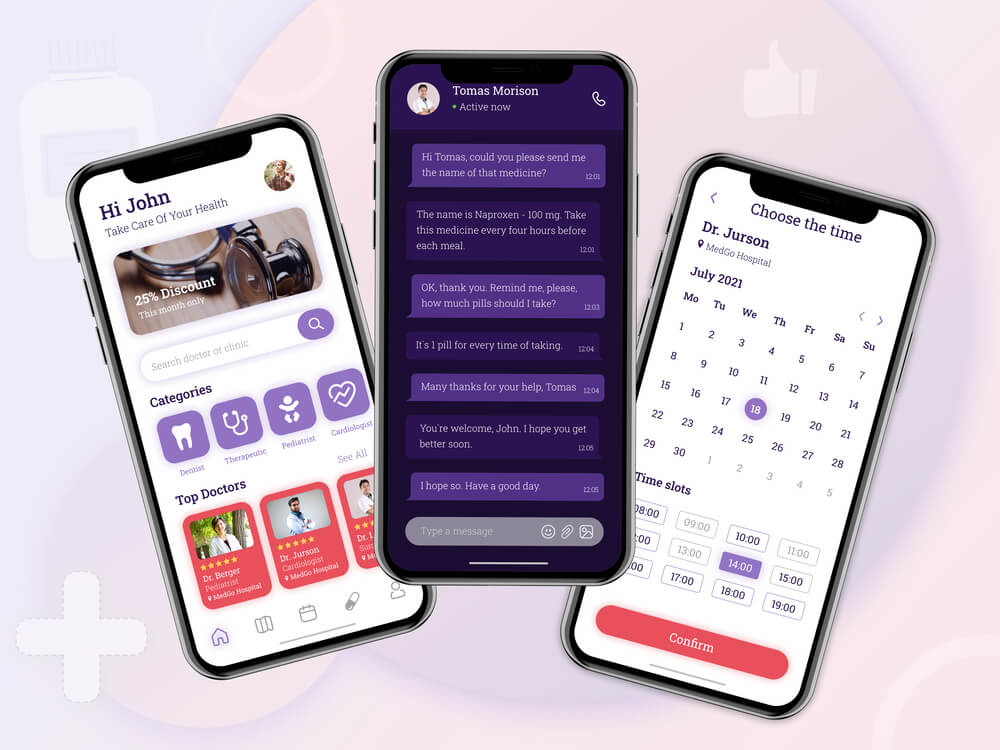
Text/video chat
This is the main feature that connects doctors to patients. You can implement either text chat, video chat, or both for the most convenient experience. Don’t forget to add the ability to attach media to text messages so users can share files and photos.
Geolocation
A location-aware feature is needed to verify that a patient and doctor are from the same area – for example, that they’re located within the same state in the US. This is important as states have different regulations.
Payment gateway
Integrate any payment gateway that’s convenient for you and your audience to allow users to pay for consultations. We usually recommend proven services like PayPal, Stripe, or Braintree.
Push notifications
Push notifications are your primary way of communicating with your users. Send notifications to remind users of upcoming appointments, notify of successful transactions and incoming messages, and promote your services.
In-app calls
Apart from video and text chats, you can also implement regular phone calls from your app. Sometimes this may be more convenient for users who don’t have a stable internet connection. Also, calls can be used for emergencies.
Insurance plan
Add the ability to attach an insurance plan to a user’s profile to keep everything in one place and automatically send bills to the insurance company.
Features for doctors
These features will help doctors provide fast and helpful consultations.
Registration and login
Doctors should be able to register with the help of their email or mobile phone, but additional verification should be required to create an account – for example, a scan of a doctor’s licence.
Doctor profiles
A doctor’s profile should contain important information like experience and education, and allow doctors to list and verify their credentials.
Schedule and calendar
In a calendar, a doctor should be able to mark available hours for remote consultations and immediately see when an appointment is taken. Also, after a patient schedules an appointment, the doctor should confirm it.
Text and video chat
This functionality is the same for patients and doctors. Text chat is easier to implement, so you can use it for your MVP. However, video calls are more effective, so you might want to consider them in the future.
EHR review
Before a consultation, allow the doctor to check the patient’s medical history and add new information to it.
Video session recording
To control the quality of your service, you should be able to record video and audio consultations. This will protect both your users and doctors in case of a dispute.
To divide the functionality for patients and doctors, you can choose one of two options: create two separate apps united by a single backend, or make two types of profiles in one app. Your choice depends on the architecture of your app, and you can choose what’s best for you with the help of your developers and business analysts.
Challenges
Though the telemedicine industry is lucrative, it has its own challenges. Ignoring them can make your app not user-friendly at best and vulnerable to hackers at worst.
Design
UI/UX design is a challenge because a telemedicine app has to be highly functional, clear, and accessible for people with disabilities. This means it should have voice control features and a layout that looks good with fonts of different sizes and different color palettes.
Also, telemedicine applications have two types of profiles: for doctors and for patients. When creating a design, you should pay attention to these differences and approach the design from the user’s perspective.
Security
Security is the most important issue for telemedicine apps, as they involve sensitive information. To make your app secure, encrypt and obfuscate all personal data you send and receive, and use third-party servers that are compliant with all applicable laws and regulations in your target country.
For example, telemedicine apps operating in the US must comply with HIPAA, the Health Insurance Portability and Accountability Act.
Integrating with your current system
If you want to create a telemedicine app for your hospital, clinic, or medical center, you’ll need to integrate it with your current management system. This requires both technical and management skills.
Technologically, you’ll need to make sure that all the information you’ll be getting from the app will get into your current web CRM correctly and will help you get more insights instead of just piling up.
How to start a telemedicine business
1. Learn the regulations
If you wonder how to start a telemedicine business, you’ll need to learn all ins and outs of healthcare policies in your target country or region. Different countries have different legislations that protect sensitive personal data like EHR. For example, in the US, HIPAA is the main act that regulates the security measures for digital healthcare records and their use.
2. Build your strategy
The first thing you should do after you make sure you can stay compliant with the legislation in your country is to analyze your competitors. Figure out what problem you want to solve with your telemedicine app and build a strategy for its monetization, development, and marketing. All of this will allow you to form your budget and expectations.
Build your marketing, monetization and busines strategies before you start developing an app. For this, use IT consulting and marketing research
3. Choose a development company
Your telemedicine app developers should be aware of legislation and be experts in security, as it’s a priority for any mHealth app. Shortlist a few development companies and share your ideas, requirements, budget expectations, and deadlines. A good development company will perform a business analysis of your idea to create a technical specification and a detailed estimate.
4. Deploy and market your app
Develop and release your app, but plan your budget for maintenance and marketing as well. Also, partner with local clinics, hospitals, individual doctors and healthcare organizations for better reach.
Telemedicine app development technical stack
There are countless technologies you can choose from when you develop your telemedicine application. For an app, you’ll need a framework, cloud storage, various libraries, third-party integrations, servers, cashing tools, video SDKs, and more. Here are just some technologies you can use for your telemedicine app development.
Mobile app languages and frameworks:
- Kotlin (Android)
- Swift (iOS)
- Flutter (Android + iOS)
Back-end development technologies:
- Programming language: Node.js, Ruby, Python, PHP
- Videoconferencing: WebRTC, Twilio, RTMP
- Chat: Twilio, Socket.io
- Database: MySQL, PostgreSQL, MongoDB
- APIs: Stripe, PayPal, Braintree, EC2, S3
Tools:
- Google Maps for geolocation
- Firebase for notifications
- Elastic Search for search and filters
This is just an example of a tech stack that’s needed to create a telemedicine app. If you’d like to learn more about how to build a telemedicine application, don’t hesitate to contact us for a free consultation.
How much does it cost to develop a telemedicine app?
The cost of telemedicine app development consists of several factors:
- Technology stack
- Number and complexity of features
- Design and its complexity
- Hourly rate of the development team
- The number and price of third-party services you’ll use in your app (e.g. Google Maps)
The feature scope and hourly rate are the two factors that affect the development cost the most. Development company rates are usually based on a company’s experience and location.

So, how much does telehealth app cost? The whole telemedicine app development process typically consists of these steps:
- Business analysis – creating a technical specification and wireframes according to your business needs
- Design – includes detailed mockups
- Development and quality assurance – these two processes happen simultaneously, and their duration depends on the technology stack
- Security check – compulsory for telemedicine apps and includes security testing
- Deployment – releasing the app to the app stores and optimizing app store profiles for search
- Maintenance and support – includes bug fixes, updates, and tweaking the existing features
In this table, we’ll show you how many eight-hour days it may take to develop each feature we discussed in this article. Note that this estimate doesn’t include preparation, design, or maintenance: all this is required to develop a telemedicine app.
| Feature | Estimate in days |
| Personal user profiles | 2–4 |
| Login | 2–3 |
| Onboarding + tutorial | 1–2 |
| Doctors’ profiles | 2 – 4 |
| Ratings and reviews | 1–3 |
| Search | 1–2 |
| Filters | 1–2 |
| Doctor listings | 1–2 |
| Calendar | 2–4 |
| Mobile payments | 2–3 |
| Appointments | 1–3 |
| Text chat | 3–6 |
| Video calls | 4–6 |
| Push notifications | 2–5 |
| Data encryption | 2–4 |
| Patient medical histories | 2–3 |
| Consultation history | 1–2 |
| Consultation records | 1 |
Now you can calculate the cost of starting a telemedicine app startup.
Final thoughts
Telemedicine development requires lots of attention to functionality, convenience, and security. Apart from following security best practices, you and your development team should ensure the app complies with the legislation in your target country.
Telemedicine is all about enabling communication between doctors and patients, and features like text and video chats help to diagnose patients as accurately as possible. Also, these features require the most attention in terms of security, as they’re the main way sensitive information is shared.
To make your app more credible, you should add detailed information on each doctor and allow patients to review and rate doctors. This will make your telemedicine platform trusted and eventually more popular, as people will share their positive experiences with friends and relatives.
In this article, we discussed how to develop a telemedicine app, its main features, and the cost of a telemedicine startup.
We can build a telehealth app of any kind, from a small cross-platform MVP to a big enterprise solution that integrates with your internal management system. Don’t hesitate to contact us and ask any questions regarding telemedicine development. We’ll make sure each patient finds a doctor through your app.



